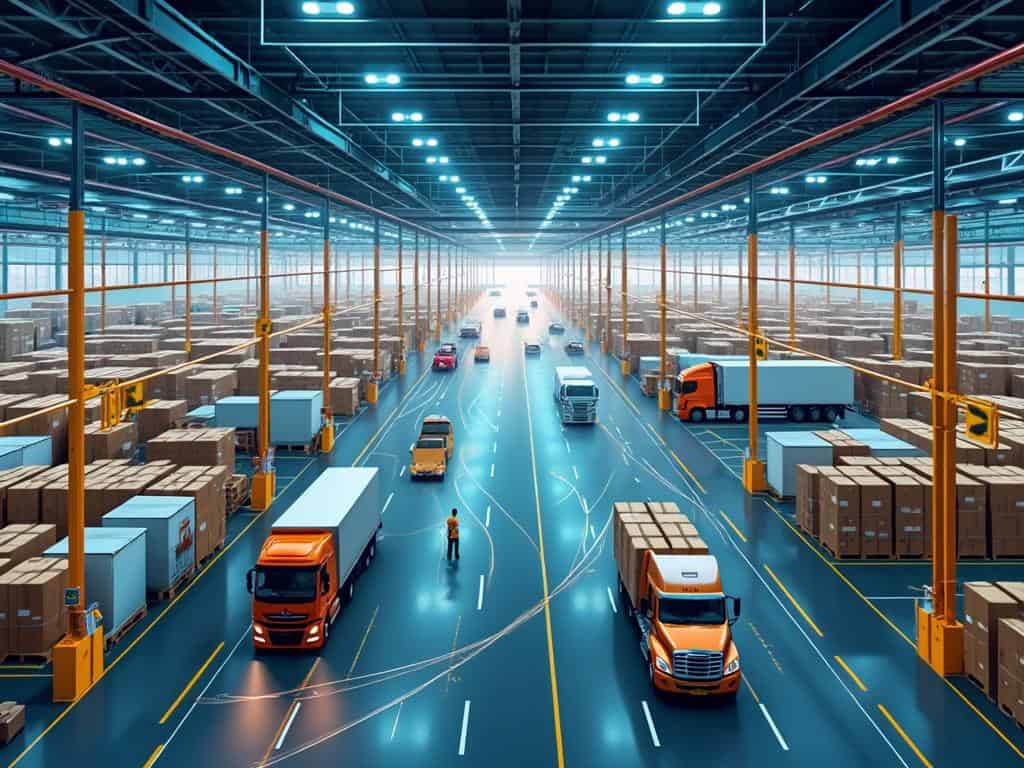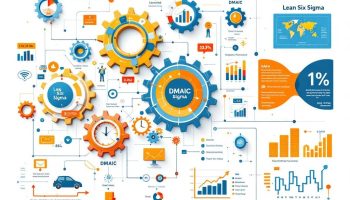
Designing and Implementing Logistics Strategy
Designing and implementing a logistics strategy optimizes the movement of goods, services, and information throughout the supply chain. By shifting from reactive to proactive management, organizations can create a competitive advantage through data-driven insights and strategic process optimization, potentially reducing supply chain costs by 15-30% while improving operational efficiency.
Key Takeaways
- Logistics strategy aims to optimize efficiency, reduce costs, and enhance customer satisfaction across the entire supply chain.
- Advanced technologies like AI, automation, and IoT are critical for transforming logistics operations.
- Implementing the SMART framework and conducting regular supply chain audits can improve operational efficiency by 15-20%.
- Demand forecasting, inventory management, and warehouse optimization are core components of an effective logistics strategy.
- Emerging challenges like demand volatility and labor shortages require adaptive and flexible strategic approaches.
A well-designed logistics strategy serves as your operational backbone, connecting procurement, production, and distribution. Research from McKinsey shows that companies with integrated logistics strategies achieve 25% higher profitability than competitors.
You’ll need to assess current operations before implementation. Analyze transportation costs, warehouse efficiency, and order fulfillment times. This assessment identifies bottlenecks and opportunities for improvement.
Technology integration forms the foundation of modern logistics strategies. Cloud-based supply chain management systems enable real-time visibility across operations. AI-powered analytics help predict demand patterns with up to 40% greater accuracy than traditional methods.
Successful strategies require clear performance metrics. Establish KPIs for delivery times, fulfillment accuracy, and inventory turnover rates. Track these metrics consistently to gauge progress and make necessary adjustments.
Transportation optimization reduces costs significantly. Consider route planning software that can cut fuel consumption by 10-15%. Evaluate multi-modal shipping options to balance speed and cost-effectiveness based on product characteristics.
Inventory management techniques like Just-in-Time (JIT) minimize storage costs while maintaining adequate stock levels. Implement ABC analysis to prioritize high-value items and optimize warehouse space. Harvard Business Review notes that effective inventory strategies can reduce carrying costs by 20-30%.
Your logistics strategy must account for risk management. Develop contingency plans for supply disruptions, transportation delays, and demand fluctuations. Create a resilient network with alternative suppliers and distribution channels.
Cross-functional collaboration ensures alignment between departments. Establish clear communication channels between procurement, production, logistics, and sales teams. Conduct regular meetings to address challenges and share insights.
Continuous improvement drives long-term success. Schedule regular strategy reviews and adjust based on performance data and market changes. Encourage feedback from employees and customers to identify improvement opportunities.
“Designing a logistics strategy that prioritizes proactive management and advanced technologies not only enhances operational efficiency and reduces costs, but also transforms the entire supply chain into a competitive powerhouse. Embracing data-driven insights and regular audits empowers organizations to navigate emerging challenges while boosting customer satisfaction and sustainability.”
What Is a Logistics Strategy?
A logistics strategy is a comprehensive plan that coordinates the movement of goods, services, and information from origin to consumption. Its primary goal is to optimize efficiency, reduce costs, and enhance customer satisfaction when designing and implementing logistics strategy. You can reduce supply chain costs by 15-30% through effective process optimization, which is crucial since logistics expenses typically account for 5-15% of total company revenue.
When designing and implementing logistics strategy, your approach should shift from reactive to proactive, using data-driven insights to make decisions. This strategic transformation helps you anticipate challenges rather than simply responding to them, creating a competitive advantage in your market.
Core Components of Logistics Strategy
Successful logistics strategy incorporates several comprehensive elements that work together to create an efficient system. These key components are essential when designing and implementing logistics strategy:
- Demand forecasting – Advanced methods can reduce inventory costs by up to 20%
- Inventory management – Optimizes stock levels and reduces carrying costs
- Warehousing – Strategic location planning reduces transportation expenses
- Transportation – Route optimization decreases fuel consumption and delivery times
- Order fulfillment – Automation can reduce order errors by up to 50%
Warehouse optimization plays a crucial role in designing and implementing logistics strategy, potentially cutting order processing times by 30%. Key systems that support these functions include SAP EWM, Oracle WMS, and Manhattan Associates Transportation Management.
Technology serves as the backbone of modern logistics optimization. When designing and implementing logistics strategy, you should consider integrating these critical technologies:
- Automation – Increases warehouse picking speeds by 50% while reducing labor costs by 25%
- Internet of Things (IoT) – Enables real-time visibility across your supply chain
- Artificial Intelligence – Improves demand forecasting accuracy by 10-20%
- Data analytics – Supports strategic planning decisions and identifies improvement opportunities
Setting long-term goals using the SMART framework provides direction when designing and implementing logistics strategy. You should conduct a comprehensive supply chain audit to identify strengths and weaknesses, then implement continuous improvement processes to achieve 15-20% higher operational efficiency.
| Strategy Component | Potential Benefit |
|---|---|
| Demand Forecasting | 20% inventory cost reduction |
| Warehouse Optimization | 30% faster order processing |
| Automation | 50% fewer order errors |
| Technology Integration | 10-20% improved forecast accuracy |
| Outsourcing | 10-20% cost reduction |
Current challenges in designing and implementing logistics strategy include demand volatility, rising fuel costs, and labor shortages that are projected to grow 15% annually through 2030. Last-mile delivery accounts for 53% of total shipping costs, making it a critical focus area for optimization.

Core Components of Logistics Strategy
A logistics strategy is a comprehensive plan that coordinates the movement of goods, services, and information from origin to consumption. Your primary goal when designing and implementing a logistics strategy should be to optimize efficiency, reduce costs, and enhance customer satisfaction. Effective logistics planning can reduce supply chain costs by 15–30% through process optimization, which is significant considering logistics expenses typically account for 5–15% of total company revenue.
Designing and implementing a logistics strategy requires understanding several key components that work together to create an efficient supply chain. These components include demand forecasting, inventory management, warehousing, and transportation systems. Advanced demand forecasting techniques can reduce your inventory costs by up to 20%, while warehouse optimization can cut order processing times by 30%. By implementing automation in your logistics processes, you’ll reduce order errors by up to 50%.
Key systems that support effective logistics strategy implementation include:
- SAP Extended Warehouse Management (EWM)
- Oracle Warehouse Management System (WMS)
- Manhattan Associates Transportation Management
Technology plays a crucial role in implementing a successful logistics strategy. Automation, Internet of Things (IoT), artificial intelligence, and data analytics are transforming how companies design and execute their logistics operations. Warehouse automation increases picking speeds by 50% and reduces labor costs by 25%. AI-driven demand forecasting improves accuracy by 10–20%, while real-time tracking enhances decision-making and customer communication.
Strategic Development Process
When designing and implementing a logistics strategy, you should follow a structured approach. Set long-term goals using the SMART framework (Specific, Measurable, Achievable, Relevant, Time-bound) and conduct a comprehensive supply chain audit. Companies that regularly review their strategies achieve 15–20% higher operational efficiency than those that don’t.
The following table illustrates the key phases of designing and implementing a logistics strategy:
| Phase | Activities | Expected Outcomes |
|---|---|---|
| Assessment | Supply chain audit, SWOT analysis | Gap identification, baseline metrics |
| Planning | Goal setting, resource allocation | Strategic roadmap, budget approval |
| Implementation | System integration, staff training | Process optimization, error reduction |
| Monitoring | KPI tracking, performance reviews | Continuous improvement, adaptability |
Your logistics strategy must address emerging challenges including demand volatility, rising fuel costs, and labor shortages. Last-mile delivery accounts for 53% of total shipping costs, and labor shortages are projected to grow 15% annually through 2030. Forward-thinking companies are focusing on continuous improvement processes and evaluating outsourcing potential, which can reduce costs by 10–20%.
When designing and implementing a logistics strategy, integrate technology and data-driven decision-making while developing flexible, adaptive frameworks. Prioritize both customer satisfaction and operational efficiency to transform your logistics operations for business success.
Expert Insight: To develop an effective logistics strategy, focus on integrating advanced technologies such as AI and automation while continuously adapting to emerging challenges like demand volatility and labor shortages. Employ the SMART framework for setting clear goals and conduct regular supply chain audits to identify gaps and improve operational efficiency by 15-20%. Finally, ensure strong communication and collaboration across all logistics components—demand forecasting, inventory management, warehousing, and transportation systems—to enhance customer satisfaction and reduce costs effectively.
Technology-Driven Logistics Optimization
Technology plays a pivotal role in designing and implementing logistics strategy for modern supply chains. The right technological solutions can transform your operations, driving efficiency and creating competitive advantages. When designing and implementing logistics strategy, integrating advanced technologies isn’t optional anymore—it’s essential for survival.
Warehouse automation stands out as a game-changer in logistics optimization. By implementing automated solutions, you’ll experience up to 50% faster picking speeds while reducing labor costs by approximately 25%. These efficiency gains directly impact your bottom line when designing and implementing logistics strategy that delivers results.
Artificial intelligence represents another cornerstone of modern logistics technology. AI-driven demand forecasting improves accuracy by 10-20%, helping you maintain optimal inventory levels. This predictive capability is crucial when designing and implementing logistics strategy that can adapt to market fluctuations.
Key Technologies Transforming Logistics
Several technologies are reshaping how companies approach designing and implementing logistics strategy:
- Internet of Things (IoT) sensors that provide real-time visibility across your supply chain
- Predictive analytics that identify potential disruptions before they impact operations
- Robotic process automation that streamlines repetitive tasks
- Cloud-based platforms that enable seamless collaboration with partners
- Blockchain solutions that enhance transparency and traceability
Real-time tracking capabilities have become indispensable when designing and implementing logistics strategy. These systems enhance decision-making by providing instant visibility into shipment status, location, and condition. This database analytics approach transforms how you communicate with customers and respond to disruptions.
| Technology | Efficiency Improvement | Cost Reduction | Customer Satisfaction Impact |
|---|---|---|---|
| Warehouse Automation | 30-50% faster processing | 15-25% lower labor costs | 40% fewer order errors |
| AI-Driven Forecasting | 10-20% better accuracy | 15-30% lower inventory costs | 25% fewer stockouts |
| IoT Tracking Solutions | 35% improved visibility | 10-15% reduced waste | 45% better delivery estimates |
| Data Analytics Platforms | 25% faster decision-making | 10-20% optimized routing | 30% improved service levels |
When designing and implementing logistics strategy, you must evaluate which technologies align with your specific business needs. The project implementation key phases should include comprehensive technology assessment, pilot testing, and phased deployment to minimize disruption.

Strategic Development and Implementation
Effective designing and implementing logistics strategy requires a structured approach that aligns with your business objectives. A well-executed logistics strategy can transform your supply chain operations, reducing costs by 15-30% through targeted process optimization. With logistics expenses typically accounting for 5-15% of total company revenue, strategic improvements directly impact your bottom line.
Setting the Foundation for Logistics Excellence
To begin designing and implementing logistics strategy effectively, you need to establish clear long-term goals using the SMART framework (Specific, Measurable, Achievable, Relevant, Time-bound). This foundation ensures your logistics initiatives remain focused and measurable. Conducting a comprehensive supply chain audit helps identify opportunities for improvement across your logistics network.
Regular strategy reviews are essential for maintaining high performance. Companies that consistently evaluate their logistics approaches achieve 15-20% higher operational efficiency than those who don’t. This continuous improvement process should examine:
- Transportation network optimization
- Warehouse layout and flow
- Inventory management protocols
- Technology integration points
- Supplier relationship management
- Customer delivery expectations
Evaluating outsourcing potential represents another strategic consideration when designing and implementing logistics strategy. Selective outsourcing can reduce operational costs by 10-20% while allowing you to focus on core competencies. Before conducting a make-or-buy analysis, assess which functions might benefit from external expertise.
The technology component of your logistics strategy should incorporate automation, IoT, AI, and advanced analytics. Warehouse automation alone can increase picking speeds by 50% while reducing labor costs by 25%. When designing and implementing logistics strategy with technology at its core, you’ll gain competitive advantages through:
- AI-driven demand forecasting (10-20% improved accuracy)
- Real-time tracking for enhanced decision-making
- Automated inventory management systems
- Route optimization software
- Predictive maintenance capabilities
The implementation phase requires careful project implementation planning with clear timelines, resource allocation, and change management protocols. Creating measurable KPIs allows you to track progress and adjust your approach as needed. Your logistics strategy implementation should address emerging challenges like demand volatility, rising fuel costs, and labor shortages projected to grow 15% annually through 2030.
By thoughtfully designing and implementing logistics strategy with these components in mind, you’ll build a more resilient, efficient supply chain positioned for long-term success.
Companies that effectively manage their supply chains can achieve up to 15-20% reductions in logistics costs, significantly impacting their overall profitability.
forbes.com
Emerging Challenges and Future Trends
Logistics strategy development faces unprecedented challenges in today’s fast-paced business environment. You’ll need to consider designing and implementing logistics strategies that address both current obstacles and upcoming shifts in the industry.
The volatility of customer demand continues to disrupt even the most carefully designed logistics operations. This unpredictability requires you to build flexibility into your logistics framework, with approaches that can quickly adapt to changing conditions. Companies that successfully implement responsive strategies can transform these challenges into competitive advantages.
Rising fuel costs have dramatically impacted transportation budgets, with last-mile delivery now accounting for 53% of total shipping costs. Your logistics strategy must incorporate fuel optimization techniques and alternative delivery methods to control these expenses. When designing and implementing logistics strategy, consider multi-modal transportation options that can help reduce your carbon footprint while managing costs.
Labor shortages present another significant hurdle, projected to grow 15% annually through 2030. This workforce gap requires strategic planning solutions that leverage automation and technology to compensate for reduced human resources. Your logistics strategy should address recruitment, retention, and training alongside technological implementations.
Future-Focused Strategies
The following trends are reshaping logistics strategy implementation:
- Green logistics initiatives that reduce environmental impact while improving efficiency
- Autonomous delivery systems decreasing dependence on traditional labor forces
- E-commerce integration solutions providing seamless omnichannel experiences
- Blockchain applications enhancing supply chain transparency and security
- Predictive analytics improving forecasting and inventory optimization
When designing and implementing logistics strategy, you should focus on sustainability initiatives that meet growing consumer expectations. Companies implementing green logistics strategies have seen both cost reductions and improved brand perception, demonstrating that environmental responsibility and profitability aren’t mutually exclusive.
The implementation phases of projects involving autonomous technology are accelerating, with self-driving trucks and drones moving from concept to reality. Your strategy should include plans for integrating these technologies as they mature, preparing your infrastructure and systems for their adoption.
This table summarizes key challenges and their strategic implications:
| Challenge | Impact | Strategic Response |
|---|---|---|
| Demand Volatility | Inventory imbalances | Implement AI-driven forecasting |
| Fuel Costs | Higher transportation expenses | Develop multi-modal optimization |
| Labor Shortages | Operational constraints | Accelerate automation integration |
| Sustainability Demands | Compliance requirements | Create green logistics initiatives |
| E-commerce Growth | Fulfillment complexity | Design omnichannel logistics solutions |
To remain competitive, your logistics strategy must accommodate these changing dynamics while designing and implementing logistics strategy elements that maintain operational excellence.
Transforming Logistics Strategy for Business Success
Designing and implementing logistics strategy effectively can transform your business operations and deliver significant competitive advantages. A comprehensive logistics strategy coordinates the movement of goods, services, and information from origin to consumption point. Your primary goal should be optimizing efficiency, reducing costs, and enhancing customer satisfaction throughout the supply chain.
A well-executed approach to designing and implementing logistics strategy can reduce supply chain costs by 15–30% through process optimization. With logistics expenses typically accounting for 5–15% of total company revenue, these savings directly impact your bottom line. The modern logistics landscape requires shifting from reactive problem-solving to proactive, data-driven strategic planning.
Core Components of Effective Logistics Strategy
When designing and implementing logistics strategy, you must address several interconnected elements:
- Demand forecasting
- Inventory management
- Warehousing operations
- Transportation networks
- Distribution planning
- Reverse logistics
Advanced demand forecasting techniques can reduce your inventory costs by up to 20%, while warehouse optimization cuts order processing times by approximately 30%. You’ll also experience up to 50% fewer order errors through automation implementation. The strategic planning process should identify which components need the most attention in your specific operation.
Technology plays a crucial role in designing and implementing logistics strategy. Critical technologies to consider include:
- Automation systems for warehouse operations
- Internet of Things (IoT) for real-time tracking
- Artificial intelligence for predictive analytics
- Data analytics platforms for performance measurement
Warehouse automation increases picking speeds by 50% while reducing labor costs by 25%. AI-driven demand forecasting improves accuracy by 10–20%, enabling better inventory management. The implementation phase of your logistics strategy should prioritize technologies with the highest ROI potential.
For successful strategy development, set long-term goals using the SMART framework and conduct a comprehensive supply chain audit. Organizations that regularly review their logistics strategies achieve 15–20% higher operational efficiency. Implementing continuous improvement processes ensures your strategy evolves with changing market conditions. Evaluating outsourcing potential can reduce costs by an additional 10–20% for non-core functions.
The following table summarizes key metrics to monitor when designing and implementing logistics strategy:
| Metric | Target Improvement | Impact |
|---|---|---|
| Order fulfillment rate | >98% | Enhanced customer satisfaction |
| Inventory turnover | 15-20% increase | Reduced carrying costs |
| Transportation costs | 10-15% reduction | Improved profit margins |
| Order cycle time | 25-30% reduction | Faster customer service |
| Returns processing | 40-50% faster | Better customer experience |
Your logistics strategy must address emerging challenges including demand volatility, rising fuel costs, and labor shortages. With last-mile delivery accounting for 53% of total shipping costs and labor shortages projected to grow 15% annually through 2030, designing and implementing logistics strategy requires forward-thinking approaches.






